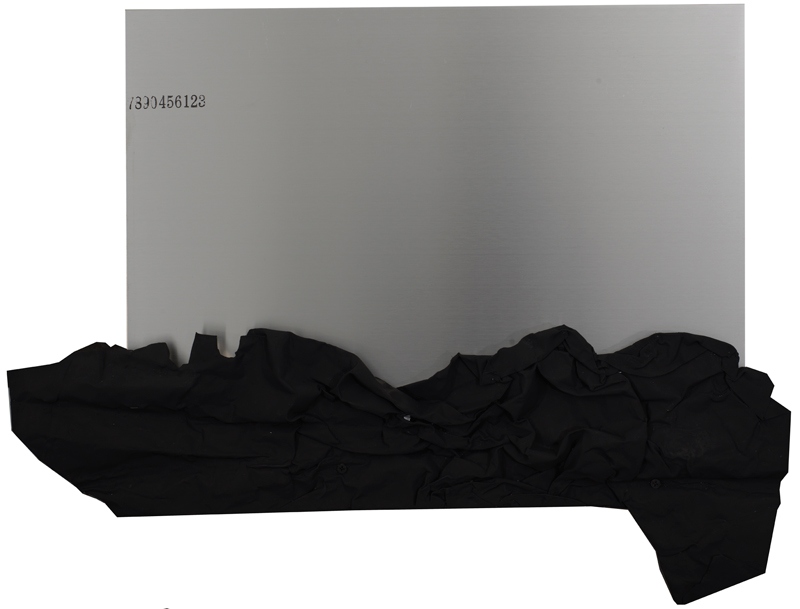
Artist:Wang Jiazeng

Video screenshot
Wang Jiazeng collected some abandoned iron boards, which have behind them rich and long history. They came from the nature and were made into various forms and patterns through industrial processing(made and tested repeatedly). They are smooth, neat and rigid in their fixed patterns and modeled for easy use in different purposes. In other words, these iron boards are target-oriented and have been produced for commercial purposes. They flow out of different iron and steel mills and show up in the world through twists and turns. Some of them were used on different objects and are now separated from those objects to become material again, while there are others that have stayed unused for their lifespan and weathered into wastes directly – they became useless from the time they had been produced.

The fold of objects-9, Metal material
The fold of objects-10, Metal material
Right here, each piece of the iron boards has its unique history and has been woven into a chain of fates. Their life also underwent ups and downs, dispite of the fact that their biography never read. Accidentally, Wang Jiazeng selected them (maybe ran into them in a market of recyclings or search for them as a reminder of his own past.) He just grab them over and interrupted their life course, and put them on a unpredictable road to the future. Eventually, Wang Jiazeng turns them into his own history – section of his history of art.

The fold of objects-7, Metal material, 85.6 x 120cm,2018
These boards were changed into different track – in space, meaning or others. Their shapes have been changed by Wang Jiazeng. Wang seems to hate their hardness and texture and their functional purposes, even their industrial nature is so unacceptable, therefore he just tortures them and tramples on them during his aimless reproduction that features squeezing and twisting, resulted in spreading wrinkles in irregularity. These iron boards, on the other hand, are subjected to pains and misery. He passed for tearing them up, and during such torture he gets his joy from the moaning of the iron boards. The grey or black iron board lose their qualities as functional products under his strikes. They were turned into pure material being without any function. This is Bataille destruction – material being liberated from utilitarianism.

The fold of objects-8, Metal material ,85.6 x 120cm,2018

The fold of objects-12, Metal materials,30 x 60cm,2018
Meanwhile, their nature was exposed under such bending, folding and tearing. The function-based iron boards have their nature covered by their patterns, while when they are turned into iron as it is, the nature of iron as a kind of material becomes visible. The iron wastes have scars on them, that are going to be made worse after repeated strikes: the strong iron finally reveals its weakness. It struggles desperately, or it has died and its remains display failure. Material substance hereby demonstrates its dual characters – hardness and weakness; smoothness and cracks; sharpness and scars. Finally it becomes hostile to itself. It swings between the two properties, and any definitive shape or property it still possesses? Wang Jiazeng handles the materials in exactly the opposite way to industrial production – not only does he try to crash the iron boards, but to ruin the process by which they used to be made into products. He seems to mock and revenge industrialism by twisting the boards randomly, and such twists change the shape and property of the material and the productive process of making the material.

The fold of objects -13,Metal materials,40 x 50cm,2018
Why treat the iron boards this way? The answer may lie in his reflection on industrialism. The iron boards indicate industrialism (that is why he would go back to Shenyang to search for iron boards). The way to treat them is to mock industrialism for its invasion on human nature. While human treats iron and steel violently, don’t they apply equal violence on human? Isn’t it the counterattack that human launches on the metal? In the time of industrialization, iron and human are integrated. Human is controlling the machine and is controlled by the machine; human harms the iron and is harmed by it. The mutual unfriendliness is the rule of the industrial age. Wang Jiazeng painted many human figures being wrapped up by iron containers. The figures are surrounded by iron like being jailed, each of them without facial image and treated like sequential codes. He, in turn, puts the iron objects into jail and and hangs them on the wall, or ties them up onto steel boards or to jail them the way they used to do to human figures, and code them in the same way. This is a true revenge.

The fold of objects-21, Metal material,150 × 180cm,2018
However, this is not just a simple trade of place between human and iron. The biography of iron, if we do not put it in an industrial context, completes a new chapter. Comparable to human being, the fate of physical objects is also unpredictable. When the twisted and queezed iron boards are place into tiny, bright container, they are endowed with mystery. Why they are pick out of the pile of iron boards? Why they are pressed into this shape? Why they settle in this place and why they attract attention? These folded iron objects present accidental moments or lasting state? Are they made into the shapes purposely? And is it the fate of the object or made so by human?

Field series

Field-5,Metal materials ,55 x 70cm,2018
Maybe all of these is accidental, and accidentality means mystery that needs to be kept in secret.
